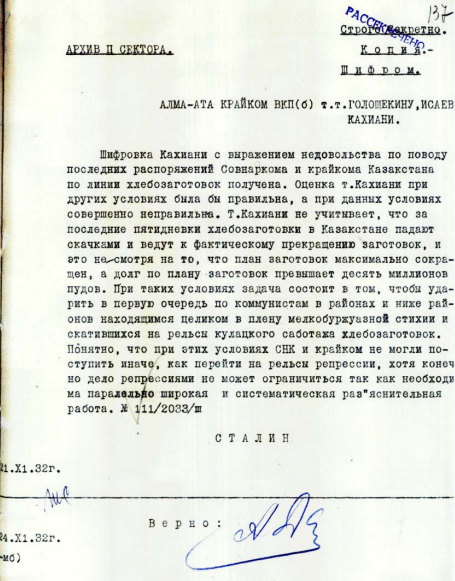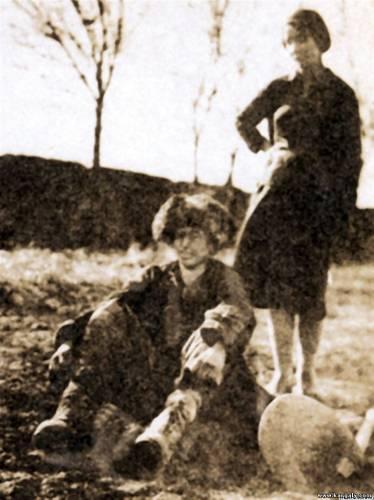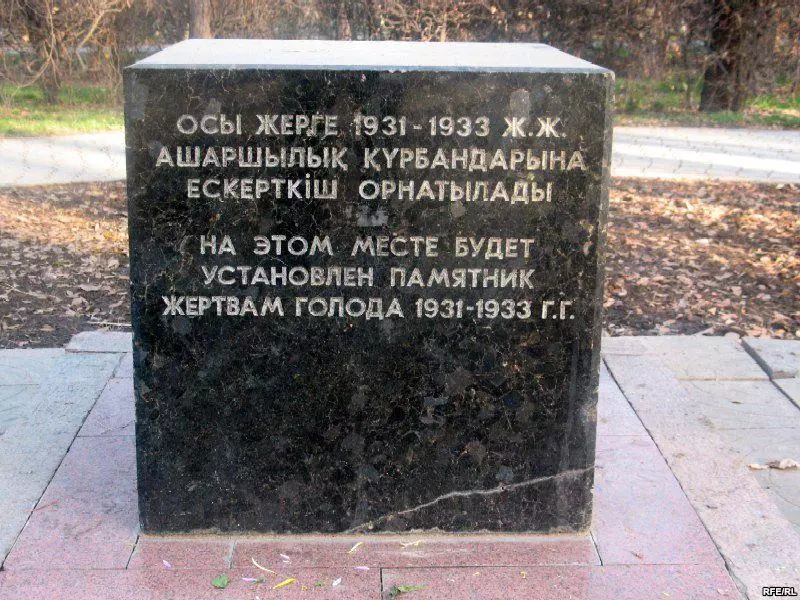The subject of Holodomor, an artificial famine of Stalin’s creation that took the lives of millions of Ukrainians during 1932-33, was a subject of political speculation in Ukraine during the time of pro-Russian president Yanukovych, who denied its genocidal essence. With a record number of Russians viewing Stalin in a positive light, Russian politicians or spokespersons in an attempt to conceal the bloody outcomes of his policies either deny that the Holodomor occurred, or that it was genocide towards Ukrainians. The Ukrainian Holodomor, while underexposed, is nonetheless being discussed. However, there is a crime of Stalin against humanity that goes relatively unnoticed – the artificial famine against Kazakhs, or the Goloshchekin genocide.
In 1876, in the Russian town of Nevel, a little Bolshevik figure by the name of Philip Isaevich Goloshchekin was born. The young Goloshchekin discovered Marxist radicalism quickly and joined the burgeoning Russian Social Democratic Labour Party party in 1903 to which he sided with Lenin.[1] He quickly rose through the Bolshevik ranks so that, by 1918, it was he that helped organise the execution of the imprisoned Tsar and his family in Ekaterinburg.[2] Despite this however, Goloshchekin remains a shady and little explored person, indeed as I type he does not currently even own his own English language Wikipedia page. Nonetheless, he was a very important figure in one of Stalin’s great crimes which consisted of the use of famine and national oppression but arguably is even less known than the Holodomor. To illustrate the point, the name of this crime against humanity, when it is even discussed at all, is sometimes directly called after him, the “Goloshchekin genocide,”[3] because it was he that ensured that Stalin’s policies in Kazakhstan were ruthlessly enforced.
Kazakhstan on the face of it is almost like a direct opposite to Ukraine. The Ukrainian lands are known for their fertile soils and Ukraine is often considered a “breadbasket state.” Ukraine has a lengthy history of permanent settlement across the countryside; during the time when Ukraine was part of the Russian empire and the USSR, it was Ukrainians that formed the ethnic majority. Kazakhstan on the other hand, despite it being much larger than Ukraine, is mostly either desert or semi-desert with the only strip of fertile land being to the north.

Because it is located within the depths of the Eurasian continent, the Kazakh climate endures wilder temperature extremes, with the winters being colder and the summers hotter than in Ukraine. In order to survive these conditions, traditional Kazakh tribes had to keep moving with their livestock to find adequate pasturage in accordance with the seasons.

The few settlements that there were, such as Almaty were based around the few available reliable bodies of water. Almaty is located within the basin of Lake Balkhash near the Kazakh-China border. Others, such as the current capital Astana, grew out of Russian imperial outposts during the Tsarist expansions.
Getting a culture that developed in such conditions to conform to the rigidity of collectivization was obviously going to take Stalin and his acolytes like Goloshchekin far more effort than usual. The climatic divide between North and South provided that the northern areas that could produce food were to be given special treatment, whilst the desolate south could be used to forcibly settle “Kulaks” – families that resisted collectivization, both from Kazakhstan and other parts of the USSR that Stalin took to collectivizing .During the 1930s approximately 64,000 Ukrainian “Kulak families” ended up here.
The initial collectivization drive in Kazakhstan, launched in 1929, was fraught with impossibly high demands from the outset. As in Ukraine, unrealistic requisition targets for grain were set by Stalin with demands that they be fulfilled to the letter. For example, in one letter Stalin sent to Goloshchekin on 31 January 1931, he insisted on “unconditional fulfilment” of the quotas and demanded that Goloshchekin take “all necessary measures” to ensure that they were.

Stalin’s insistence on fulfilment no matter what the targets were was a cue for a barrage of secret police to ensure that all grain or livestosk that could be handed over was handed over to the state! From the evidence that we have, it seems that some Kazakhs did not take this lightly at all. Being forced to stay in one spot and to endure endless searches generated resistance from the outset:
“These policies were initially greeted with a wave of resistance in 1929 on the part of the Kazakh pastoral population that varied according to region and lasted until 1931. Insurrectionist movements (and even guerrilla activities in the Mangyshlak region) evolved into episodic rioting involving several thousand people as organized protests flared across Kazakhstan during the early years of collectivization, but these movements gradually subsided as the famine became more severe.”[4]
Not every Kazakh was a participant in these riots, but to Stalin this didn’t matter, because it gave him the pretext he wanted to fully crush the Kazakh peoples. In one encrypted telegram i’ve already quoted in the article “On Holodomor denial and fisking a denialist professor of history,” sent to the Communist leadership of Kazakhstan on 21 November 1932, he would accuse the Kazakh peoples, including even local Kazakh communists, of sabotaging his plans. In the process, he used the same set of lies that he used as a pretext to crush Ukraine. “It must be understood that under such conditions,” Stalin wrote, “the Soviet of People’s Commissars and the regional [Communist] party committee could not take any path but that of repressions, although, obviously, repressions alone will not suffice, and parallel to repressions we need a wide and systematic propaganda campaign.”

The results were as predictable as they were tragic. Religious and tribal authorities were persecuted. A dekulakization campaign was stepped up to squeeze all the food possible out of the Kazakh peoples, and because the Soviet state took more food than what could be produced, famine broke out and people got very desperate very quickly. One account reproduced here tells of daughters sold at young ages for sacks of grain.


Tatiana Nevadovskaya, a young Russian woman trying to help a starving Kazakh
A valuable account of that time is one of a young Russian woman, Tatiana Nevadovskaya, that tried to help a starving Kazakh. In Nevadovskaya’s own words [sic]:
“Early spring 1933, I went with someone from the staff. Had a camera with me … on the highway near our house was sitting a exhausted, famished Kazakh. He dragged himself with difficulty from the field work, exhausted, groaning, and asked to eat and drink. I handed the camera to my companion and hurried to fetch water (su…) – he drank greedily. I did not notice when my friend took a picture of me (that’s the photo). I hurried back home to bring him a piece of bread and sugar. When I approached him with the bread … he was already dead.”
Nevadovskaya was a valuable eyewitness to the catastrophe. Her memories of the early 1930s haunted her for the rest of her life.
In another account, a secret communication produced by the OGPU on 31 March 1933, we hear of a woman arrested in what is now the city of Taraz between 11-16 February 1933 because she had resorted to cannibalism – cooking the corpse of a 6-7 years old child for food.

According to one estimate, this famine took the lives of approximately 1.45 million people[5], which given the sparsity of the Kazakh people at the time amounted to approximately 1/3 of the Kazakhs. In fact, this famine struck down such a great swathe of Kazakh society that it even made the ethnic Kazakhs an ethnic minority in their own lands until the 1980s. Given the “pretexts”, the modus operandi of the Soviet state in Kazakhstan and the disproportionate level of suffering, it’s not hard to see why the situation in Kazakhstan in the early 30s is compared to the situation in Ukraine in the early 30s. However, except for odd mentions here and there, there is now a great difference between Ukraine & Kazakhstan when it comes to discussion of these two great tragedies. In Ukraine, it is now completely possible to talk about Holodomor. In the light of the current crisis between Ukraine and Russia, it has now arguably become centre-stage when it comes to discussing Ukrainian history itself. In Kazakhstan, discussions seem to take the form of hushed tones when it comes to the “Goloshchekin genocide.” The question is, why?

The answer to that question can be found in the form of the current Kazakh president, Nursultan Nazarbayev. Nazarbayev is a Yanukovych-esque dictator who has presided over his people since the dissolution of the USSR. His regime is known for its crackdown of civil liberties and political freedoms. Naturally, he is an ally of Putin and the economy of Kazakhstan is now heavily dependent on its exports of oil and minerals to Russia and imports of Russian goods, and the arms industries of both nations are heavily interlinked, so much so that it is sometimes said that these two nations enjoy a “special relationship” with each other. The influence that Moscow has over Astana would have been clearly seen when, on 29 May 2014, it was Nazarbayev (along with Belarusian dictator Lukashenko) who signed Putin’s dream of a “Eurasian customs union.” The influence of the relationship between the two authoritarians on Kazakh historiography has been quite profound. Nazarbayev has taken the same line on the Goloshchekin genocide as Yanukovych took on the Holodomor. Nazarbayev does not recognise the “Goloshchekin genocide” as genocide. As a result, there is little in the way of active memorial service in Kazakhstan to its victims and talk of it is often dismissed as “politicisation.”[6] This line of historiography has done a great deal of damage to public knowledge and perhaps it is little wonder then why even fewer people know what Goloshchekin did in Kazakhstan than what Stalin’s acolytes did in Ukraine.
Source : Euromaidan Press
